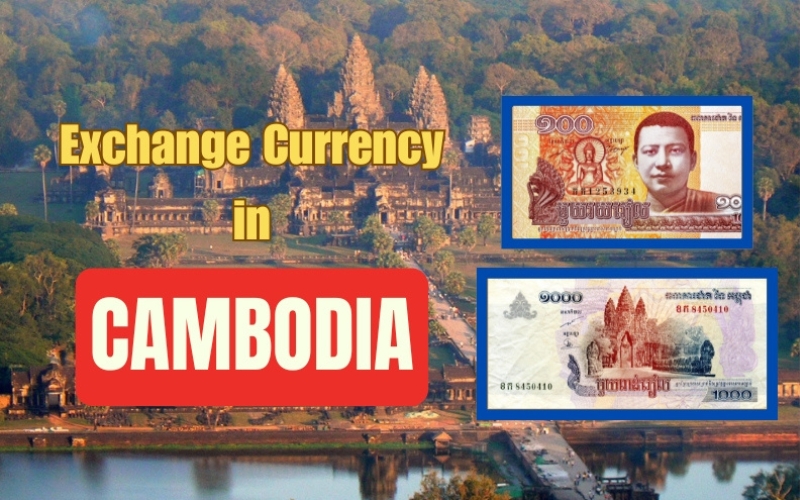
Cambodian Currency Exchange is essential knowledge for a smooth journey through the mysterious land of temples, where the golden traces of the glorious Angkor civilization are beautifully preserved. Cambodia boasts a unique currency system that reflects the distinctive blend of its economic and tourism life. Travelers visiting this fascinating country will be intrigued to find that both the traditional Riel and USD are widely used in everyday transactions. In this guide, we’ll explain how this dual money system works, giving you practical tips to manage your finances safely and effortlessly while traveling. Ready to master the art of money in Cambodia? Let’s find out together with IDC Travel!
Cambodia Currency Overview: Which Currency Do They Use, Riel or USD?
The official Cambodian currency is riel (symbol: ៛, code: KHR). However, U.S. dollars (USD) are also widely accepted throughout the country, especially in cities and tourist areas. Most prices are quoted in both Riel and USD, and you’ll often receive change in riel for small amounts. For daily transactions, you may use both Riel and USD side by side.
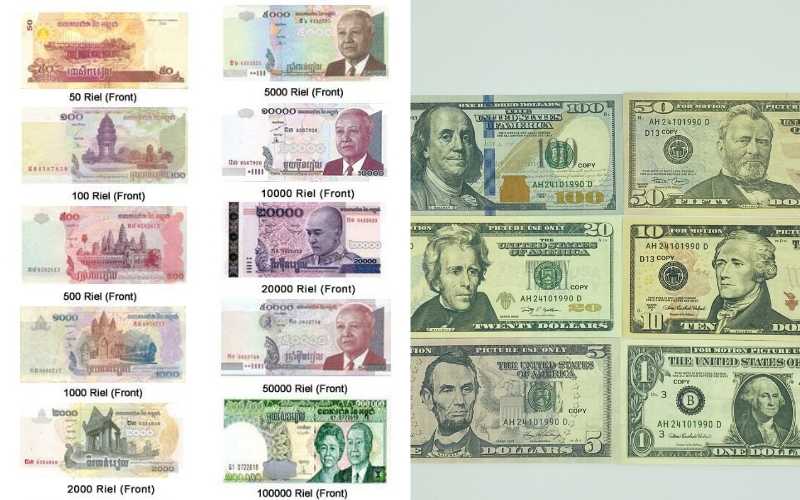
Riel and USD are accepted nationwide in Cambodia
The Riel is the official currency of Cambodia, first issued in 1953 by the National Bank of Cambodia. Besides, the USD is also widely used in Cambodia — almost functioning as the country’s second currency. A unique feature is Cambodia’s dual currency system: you can pay in USD and receive change in Riel without any issues.
The Cambodian Riel (៛ KHR)
It’s especially useful in local markets and more rural areas.
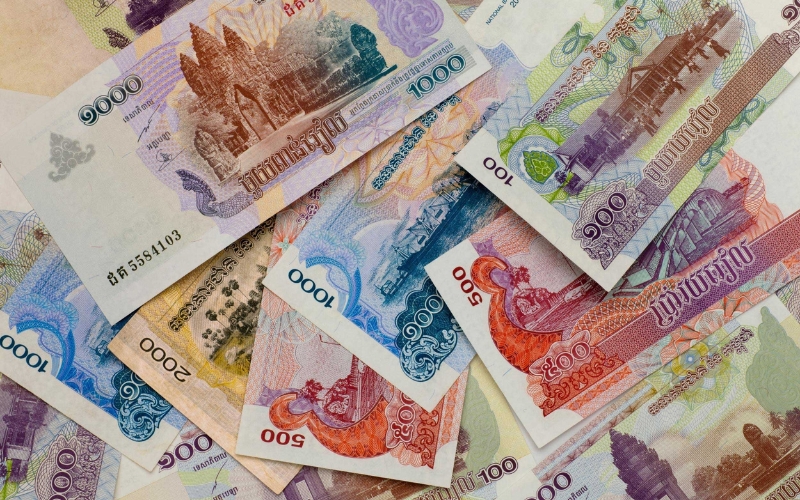
The Cambodian Riel
- Think of it as: Your currency for small, everyday purchases.
- Common Banknotes: 100៛, 500៛, 1,000៛, 5,000៛, 10,000៛, 20,000៛, 50,000៛, 100,000៛.
The U.S. Dollar ($ USD)
It’s often used in luxury hotels, restaurants and expensive points in big cities.
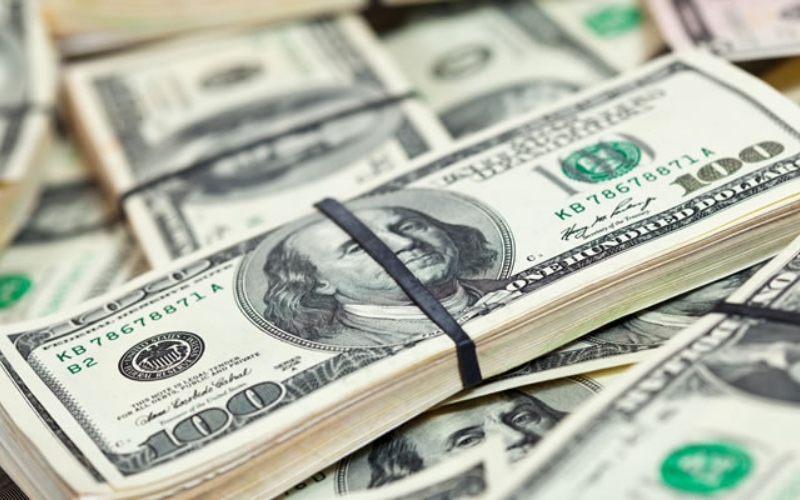
The U.S. dollars
- Think of it as: Your currency for most of your spending.
- Common Banknotes: $1, $5, $10, $20.
Cambodian Currency Exchange Rate
Here’s the golden rule that will make everything simple: 1 USD = 4,000 Riel.
In practice, the exchange rate from USD to Riel can go slightly over 4,000, but people usually just round it to 1 USD = 4,000 Riel to keep things simple. Since the exchange rate changes daily, don’t forget to check the latest information by visiting here.
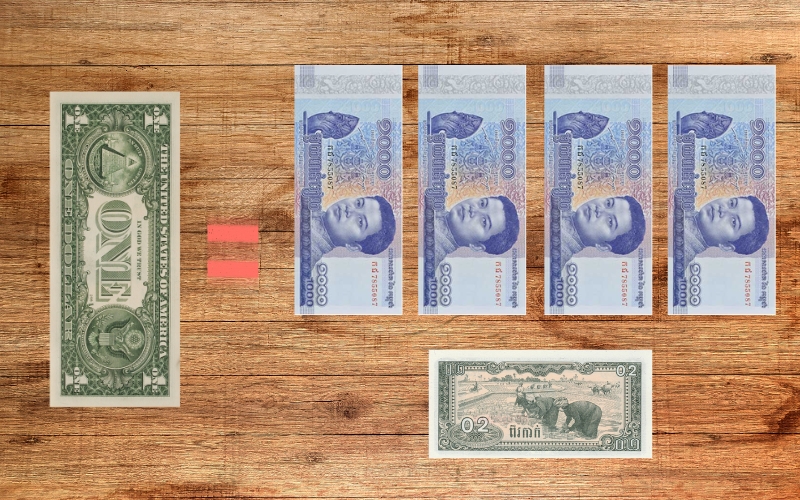
Cambodian currency exchange: 1 USD = 4002 Riel
While the official exchange rate might fluctuate slightly, nearly every shop, restaurant, and market uses this easy 4,000:1 ratio for convenience.
Here’s a typical example: You buy a souvenir for 2.50 USD. You pay with a 5 USD bill. Your change is 2.50 USD. The vendor will give you a 2 USD bill and the remaining 0.50 USD as 2,000 Riel.
Is that simple? You’ll master it within your first day. The first time, you might feel a bit confused when you receive 2,000 Riel as change for 0.50 USD. But don’t worry — I’ve been there too! You’ll become a pro after just one night at the Siem Reap night market.
Safety Tips for Cambodian Currency Exchange
Although Cambodia accepts both Riel and USD, preparing some cash before your trip is still very important. Below are a few useful Cambodia money guide we’ve learned from multiple trips to the “Land of Temples” – helping you exchange Riel and USD more smoothly, safely, and cost-effectively:
1. Exchange part of your cash before arriving in Cambodia
It’s best to exchange about 50–100 USD into Riel at a reputable bank or money exchange in your country so you’ll have some cash ready upon landing (for tuk-tuk rides, SIM cards, or snacks). Avoid exchanging all your money at the airport as the rates are usually lower.
When you arrive in Cambodia, if you want to exchange more locally, you can visit trusted major banks such as ACLEDA Bank, Canadia Bank, ABA Bank, or Wing Bank – they always display clear exchange rates and provide professional service for foreign travelers.
2. Prioritize banks and licensed exchange counters
In Phnom Penh, Siem Reap, or Sihanoukville, there are many Cambodian currency exchange points, but banks and officially licensed counters are always the safest. They will give you the correct official rate and 100% genuine money.
Some reliable banks that travelers should look for include ABA Bank, Canadia Bank, ACLEDA Bank, Wing Bank, or Phnom Penh Commercial Bank (PPCB). In addition, many 4–5 star hotels also offer official exchange services with rates similar to banks – convenient and equally safe.
Try to avoid exchanging money in Cambodia at night markets, gold shops, or small roadside stores – where the risk of counterfeit bills is higher.
3. Carry plenty of small denominations
In Cambodia, small payments are often made with small bills (1,000–5,000 Riel or 1–5 USD). After exchanging your money, ask for smaller denominations to make daily spending easier – especially when shopping at local markets, buying street food, or paying for tuk-tuk rides.
4. Double-check the money you receive
Count the cash before leaving the counter and check whether any bills are torn, dirty, or too worn. Some shops refuse damaged or old USD bills, so if you receive such notes, request an exchange on the spot.
5. Monitor the exchange rate before converting
The exchange rate between USD and Riel fluctuates slightly each day, but most locals use the simple rate of 1 USD ≈ 4,000 Riel. However, if you plan to exchange a large amount, check the latest rate to avoid losing money.
6. Only exchange the amount of cash you need
Nowadays, Cambodia supports QR payments, e-wallets, and card payments in many places. So, there’s no need to exchange too much cash at once. Exchange just enough to cover expenses for 2–3 days, then exchange more if necessary.
7. Always keep your money in a safe place
Although Cambodia is relatively safe for travelers, carrying too much cash still poses a risk. Split your money into different places (for example, some in your wallet, and the rest in a crossbody bag or the hotel safe).
>>>Ready for an unforgettable adventure? Book Cambodia 4 days Tour: Uncover Splendors of Angkor now and discover ancient temples, vibrant markets, and hidden local gems.
When to use USD and Riel
You can use both Riel and USD, but when should you use it? You should have some riel in your wallet for paying taxi fees or buying snacks, cheap food. Besides, USD would be useful when you want to stay at larger hotels and upscale restaurants. You’ll find plenty of ATMs in all cities and tourist towns. Most dispense USD. Be mindful that your home bank and the local ATM might both charge a fee per withdrawal.
If you visit Cambodia and want to experience local life, Riel will be very useful for everyday expenses.
-
When strolling through markets or food streets, you can use Riel to buy street food such as crepes, nom banh chok, or fresh fruit. Prices range from 1,000 – 10,000 Riel (around 0.25–2.5 USD) per item.
-
Short tuk-tuk rides within the city usually cost about 5,000–15,000 Riel (1.25–3.75 USD) per trip.
-
A glass of sugarcane juice, coconut water, or a street snack typically costs only 1,000–5,000 Riel (0.25–1.25 USD).
In addition, when paying with USD, change is often given in Riel, so it’s a good idea to keep some small notes handy to easily receive change and pay for small items without hassle. Using Riel for these expenses will allow you to enjoy local life more conveniently and realistically, while avoiding the need to exchange too much USD for minor purchases.
When traveling in Cambodia, USD will be very useful for larger expenses.
-
If you stay at a 3–5 star hotel or resort, room rates usually range from 15–50 USD per night for mid-range hotels, while more luxurious resorts can cost 70 USD or more.
-
Sightseeing activities and tours are often priced in USD. For example, a 1-day ticket to Angkor Wat costs about 37 USD, and 2–3 day tours can range from 60–100 USD depending on the package.
-
For dining, upscale restaurants or those serving Western, Japanese, or Korean cuisine generally accept USD, with an average meal costing around 5–15 USD, while high-end meals can start from 20 USD or more.
-
Larger services such as taxis, intercity buses, long-term car or motorbike rentals, as well as premium spas, range from 5 USD for a short tuk-tuk ride to about 100 USD per day for a private car rental, depending on your transportation needs and the level of comfort you choose.
Having USD on hand will make it easier to pay for major expenses, avoid worrying about exchange rates or change, and make your travel experience in Cambodia more convenient and comfortable.
Cambodia money guide: U.S. coins are not used in Cambodia. Any change you receive that’s less than $1 will always be given in Riel.
Our Best Advice: You should bring small notes like $1, $5, $10, and $20 with you. Larger notes like $50 and $100 would be hard for smaller shops or taxi drivers to make change for, so having a good supply of smaller notes will make your daily transactions much smoother.

You should not use large bills to pay for small transactions such as taxi fares.
Friendly Warning: Keep your U.S. bills crisp! Don’t get caught off guard! Always check your change immediately, even a slightly torn USD bill might be refused at the next stall. Be sure to check the bills you receive as change and don’t be shy about asking for a cleaner one. We wouldn’t want you to be caught in a bind.
>>>Curious to see how the colorful Cambodian Riel looks in real life? Join Unforgettable Cambodia 12 Days Adventure now and experience local life, culture, and currency up close!
Digital Payments in Cambodia
If you think you can only pay with cash when traveling in Cambodia, you’ll be pleasantly surprised. In recent years, electronic payments in Cambodia have developed rapidly, making spending more convenient, secure, and modern for tourists than ever before. Among the many e-wallet apps, Wing, Pi Pay, and Bakong are the three most popular ways to using money in Cambodia.
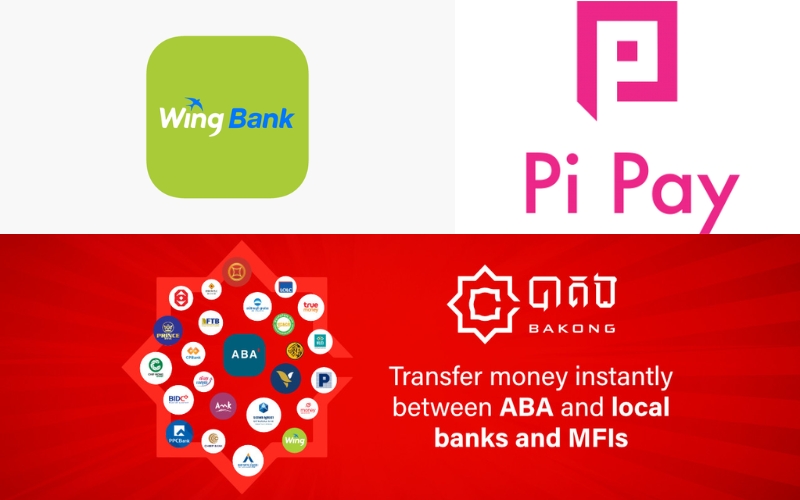
Wings, Pi Pay and Bakong are top 3 popular banking apps in Cambodia.
1. Wing
If you go to a market, call a tuk-tuk, or buy street food in Cambodia, you’ll see Wing’s blue logo almost everywhere. This is the most popular QR payment app for locals, and it’s also easy for tourists to use.
- Website: Wing Bank
- How to register: Download the Wing app from the App Store or Google Play. When you arrive in Cambodia, bring your passport to a Wing agent (found everywhere from markets and phone shops to small kiosks) to register an account and top up your funds. In some cases, a Cambodian SIM card is required to activate all features.
- Withdrawal fee: Wing allows free cash withdrawals at over 12,000 official Wing Cash Xpress agents or Wing Bank branches. However, withdrawing money via ATMs or other banks may incur a fee of up to 2% per transaction (minimum 5 USD).
- User experience: The interface might seem a bit confusing at first, but you’ll get used to it after a few uses. You can pay by scanning a QR code at most street vendors, tuk-tuks, or convenience stores.
Best suited for quick payments for small, daily expenses like food, drinks, transport tickets, or souvenirs without carrying a lot of cash.
2. Pi Pay
Pi Pay is like an extremely tourist-friendly. We recommend it for its ease of use, especially if you don’t have a local SIM card.
- Website: Pi Pay
- How to register: Download the Pi Pay app, enter your phone number (you can use a foreign number), and verify your email to complete the setup. You can top up using an international credit/debit card or at Pi Pay support locations.
- Withdrawal fee: Pi Pay charges around 0.30 USD per withdrawal (maximum 250 USD per transaction) at supported locations. If you transfer money from Pi Pay to a bank account, the fee is about 3.75 USD for transfers up to 2,500 USD.
- User experience: The English interface is clear, operations are fast, and payment is just a single scan away. You can use Pi Pay at restaurants, coffee shops, shopping malls, and even for some tourist services. Notably, the app often offers cashback or promotions for new users.
Best suited for short-term travelers who want a modern, fast payment experience without exchanging too much cash.
3. Bakong
Bakong is an electronic payment platform developed by the National Bank of Cambodia. This app is secure, professional, and supports payments in both USD and Riel.
- Website: Bakong
- How to register: Registering for Bakong is a bit more complex. You need a Cambodian bank account or must open a new one upon arrival, then use that information to create a Bakong account. The app connects directly to your bank, making it very convenient for transferring money or making large payments.
- Withdrawal fee: Bakong offers very low withdrawal fees, starting from 800 Riel (~0.20 USD) at Wing Cash Xpress agents or Wing Bank branches. Internal transfers between Bakong accounts are usually free.
- User experience: Bakong isn’t the wallet for paying for coffee or tuk-tuks, but it is extremely useful if you are living in Cambodia long-term for study or work, or need to pay for rent, tuition, or make international transfers.
Best suited if you are in Cambodia for an extended period or have financial needs beyond typical tourism.
With these three apps, you can significantly reduce the cash you carry, allowing flexible payments for everything from a coffee worth a few thousand Riel to a tour ticket costing several dozen USD — all with a simple QR code scan.
We recommend linking a bank card or top up your account with cash so you can pay for everything from coffee to tuk-tuks with a simple QR code scan. It’s a secure and convenient way to manage your spending.
>>>Planning a trip to Cambodia? Don’t miss our exciting tours in Cambodia where personalized experiences and local discoveries blend perfectly with comfort and convenience.
Your Cambodian Currency Checklist
To make sure you feel completely ready about money in Cambodia, here are our final tips.
– Arrive with Small Banknotes: Bring some cash ($1, $5, $10, $20). It would be more convenient for your trip.
– Using the Riel: You can easily buy snacks, drinks, little souvenirs and make you closer to local culture.
– Cash is Your Companion: While cards work in high-end hotels and restaurants, cash is essential for exploring markets, hiring local transport, and discovering hidden gems. Always have it on hand.
In conclusion, having knowledge about Cambodian currency exchange when travelling to Cambodia plays a important role in your experience. Remember the Cambodia money guide, exchange rate, choosing the right Cambodian currency exchange place, having a flexible combination of Riel and USD (or credit cards), and some safety tips will help you save costs, avoid risks, and remain proactive under any circumstance. If you want to explore Cambodia without worrying about Cambodian currency exchange issues, contact us and book your all-inclusive Cambodia tour now! With IDC Travel, you’ll receive exclusive financial tips and enjoy the best transportation services throughout your journey.
Read more:
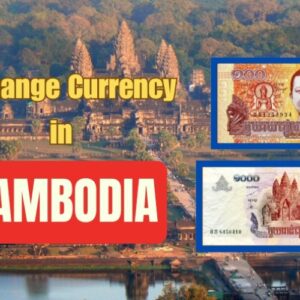
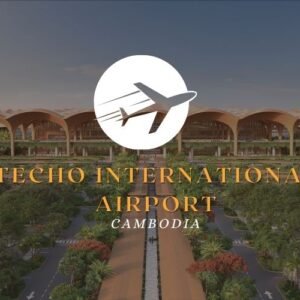


Do they accept U.S. coins?
Nope! Only paper bills. Anything below $1 will be given back to you in Riel, so you’ll naturally end up with a handful of colorful notes after a few days.
Is it safe to exchange money at markets or gold shops?
I wouldn’t recommend it. Some travelers got slightly worse rates or even old USD notes. Go to banks or trusted counters, the difference in rate is small, but peace of mind is priceless.
Should I exchange before arriving?
If you can, yes! It’s nice to land with around $50–$100 worth of Riel for your first tuk-tuk ride or quick meal. But don’t be stress — Cambodia’s full of ATMs and exchange counters, so you won’t get stuck.